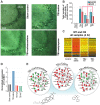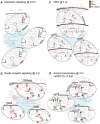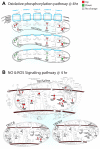Pathway analysis reveals common pro-survival mechanisms of metyrapone and carbenoxolone after traumatic brain injury
- PMID: 23326402
- PMCID: PMC3541279
- DOI: 10.1371/journal.pone.0053230
Pathway analysis reveals common pro-survival mechanisms of metyrapone and carbenoxolone after traumatic brain injury
Abstract
Developing new pharmacotherapies for traumatic brain injury (TBI) requires elucidation of the neuroprotective mechanisms of many structurally and functionally diverse compounds. To test our hypothesis that diverse neuroprotective drugs similarly affect common gene targets after TBI, we compared the effects of two drugs, metyrapone (MT) and carbenoxolone (CB), which, though used clinically for noncognitive conditions, improved learning and memory in rats and humans. Although structurally different, both MT and CB inhibit a common molecular target, 11β hydroxysteroid dehydrogenase type 1, which converts inactive cortisone to cortisol, thereby effectively reducing glucocorticoid levels. We examined injury-induced signaling pathways to determine how the effects of these two compounds correlate with pro-survival effects in surviving neurons of the injured rat hippocampus. We found that treatment of TBI rats with MT or CB acutely induced in hippocampal neurons transcriptional profiles that were remarkably similar (i.e., a coordinated attenuation of gene expression across multiple injury-induced cell signaling networks). We also found, to a lesser extent, a coordinated increase in cell survival signals. Analysis of injury-induced gene expression altered by MT and CB provided additional insight into the protective effects of each. Both drugs attenuated expression of genes in the apoptosis, death receptor and stress signaling pathways, as well as multiple genes in the oxidative phosphorylation pathway such as subunits of NADH dehydrogenase (Complex1), cytochrome c oxidase (Complex IV) and ATP synthase (Complex V). This suggests an overall inhibition of mitochondrial function. Complex 1 is the primary source of reactive oxygen species in the mitochondrial oxidative phosphorylation pathway, thus linking the protective effects of these drugs to a reduction in oxidative stress. The net effect of the drug-induced transcriptional changes observed here indicates that suppressing expression of potentially harmful genes, and also, surprisingly, reduced expression of pro-survival genes may be a hallmark of neuroprotective therapeutic effects.
Conflict of interest statement
Figures






Comment in
-
Translation experiments in traumatic brain injury … is it time to renew pharmacologic therapy?World Neurosurg. 2013 Nov;80(5):447-8. doi: 10.1016/j.wneu.2013.09.009. Epub 2013 Sep 12. World Neurosurg. 2013. PMID: 24035988 No abstract available.
Similar articles
-
Pathway-focused PCR array profiling of enriched populations of laser capture microdissected hippocampal cells after traumatic brain injury.PLoS One. 2015 May 27;10(5):e0127287. doi: 10.1371/journal.pone.0127287. eCollection 2015. PLoS One. 2015. PMID: 26016641 Free PMC article.
-
Translation experiments in traumatic brain injury … is it time to renew pharmacologic therapy?World Neurosurg. 2013 Nov;80(5):447-8. doi: 10.1016/j.wneu.2013.09.009. Epub 2013 Sep 12. World Neurosurg. 2013. PMID: 24035988 No abstract available.
-
Carbenoxolone prevents chemical eye ischemia-reperfusion-induced cell death via 11β-hydroxysteroid dehydrogenase type 1 inhibition.Pharmacol Res. 2017 Sep;123:62-72. doi: 10.1016/j.phrs.2017.07.002. Epub 2017 Jul 4. Pharmacol Res. 2017. PMID: 28687341
-
Systematic review of neurological diseases and carbenoxolone: A double-edged sword?Eur J Pharmacol. 2025 May 5;994:177387. doi: 10.1016/j.ejphar.2025.177387. Epub 2025 Feb 15. Eur J Pharmacol. 2025. PMID: 39961487
-
Neuroprotection for traumatic brain injury: translational challenges and emerging therapeutic strategies.Trends Pharmacol Sci. 2010 Dec;31(12):596-604. doi: 10.1016/j.tips.2010.09.005. Epub 2010 Oct 29. Trends Pharmacol Sci. 2010. PMID: 21035878 Free PMC article. Review.
Cited by
-
Preserved neurogenesis in non-demented individuals with AD neuropathology.Sci Rep. 2016 Jun 14;6:27812. doi: 10.1038/srep27812. Sci Rep. 2016. PMID: 27298190 Free PMC article.
-
Assessing the role of primary healthy microglia and gap junction blocker in hindering Alzheimer's disease neuroinflammatory type: Early approaches for therapeutic intervention.Front Neurosci. 2023 Jan 10;16:1041461. doi: 10.3389/fnins.2022.1041461. eCollection 2022. Front Neurosci. 2023. PMID: 36704003 Free PMC article.
-
Pathway-focused PCR array profiling of enriched populations of laser capture microdissected hippocampal cells after traumatic brain injury.PLoS One. 2015 May 27;10(5):e0127287. doi: 10.1371/journal.pone.0127287. eCollection 2015. PLoS One. 2015. PMID: 26016641 Free PMC article.
-
Comprehensive RNA Expression Analysis Revealed Biological Functions of Key Gene Sets and Identified Disease-Associated Cell Types Involved in Rat Traumatic Brain Injury.J Clin Med. 2022 Jun 15;11(12):3437. doi: 10.3390/jcm11123437. J Clin Med. 2022. PMID: 35743506 Free PMC article.
-
Diets involved in PPAR and PI3K/AKT/PTEN pathway may contribute to neuroprotection in a traumatic brain injury.Alzheimers Res Ther. 2013 Sep 26;5(5):42. doi: 10.1186/alzrt208. eCollection 2013. Alzheimers Res Ther. 2013. PMID: 24074163 Free PMC article. Review.
References
-
- Schouten JW (2007) Neuroprotection in traumatic brain injury: a complex struggle against the biology of nature. Curr Opin Crit Care 13: 134–142. - PubMed
-
- Arciniegas D, Adler L, Topkoff J, Cawthra E, Filley CM, et al. (1999) Attention and memory dysfunction after traumatic brain injury: cholinergic mechanisms, sensory gating, and a hypothesis for further investigation. Brain Inj 13: 1–13. - PubMed
-
- Zhang Z, Larner SF, Kobeissy F, Hayes RL, Wang KK (2010) Systems biology and theranostic approach to drug discovery and development to treat traumatic brain injury. Methods Mol Biol 662: 317–329. - PubMed
-
- Kasarskis A, Yang X, Schadt E (2011) Integrative genomics strategies to elucidate the complexity of drug response. Pharmacogenomics 12: 1695–1715. - PubMed
Publication types
MeSH terms
Substances
LinkOut - more resources
Full Text Sources
Other Literature Sources
Molecular Biology Databases

